Understanding Quality Assurance Terminology: An In-Depth Tutorial
Explore essential quality assurance terminology and its impact on product development and testing.

Overview:
The article "Understanding Quality Assurance Terminology: An In-Depth Tutorial" focuses on clarifying the distinctions between Quality Assurance (QA), Quality Control (QC), and software testing methodologies. It explains that QA is a proactive process aimed at preventing defects throughout development, while QC is a reactive process that identifies defects after production, emphasizing the importance of both in enhancing product quality and customer satisfaction through systematic management practices and effective testing strategies.
Key Highlights:
- Quality Assurance (QA) ensures standards throughout the development lifecycle, while Quality Control (QC) focuses on operational techniques to meet standards.
- OpsNinja's inspections helped Amazon sellers improve product ratings significantly, illustrating the impact of effective management on revenue.
- High-performing DevOps teams address critical bugs within 24-48 hours, showcasing management efficiency.
- Investing in management practices can lead to a 40% reduction in customer complaints, emphasizing the need for quality assurance and control.
- QA is proactive, aiming to prevent defects, while QC is reactive, identifying defects post-production.
- Understanding Acceptable Quality Level (AQL) metrics is crucial for supply chain oversight and improving product standards.
- Core principles of software testing include early assessment, defect clustering, and the pesticide paradox, which guide effective evaluation practices.
- Types of software testing include unit, integration, system, user acceptance, and regression testing, each vital for ensuring application quality.
- The Software Testing Life Cycle (STLC) consists of phases such as requirement analysis, test planning, and test execution, which structure the testing process.
- The software testing market is projected to grow significantly, driven by advancements in AI and technology, highlighting the need for innovative assessment solutions.
Introduction
In the rapidly evolving landscape of software development, the concepts of Quality Assurance (QA), Quality Control (QC), and testing have emerged as critical pillars for ensuring product excellence. As organizations strive to deliver high-quality software that meets user expectations, understanding the nuances between these processes becomes paramount.
From proactive measures that prevent defects to rigorous testing methodologies that validate functionality, each aspect plays a vital role in safeguarding brand reputation and enhancing customer satisfaction. This article delves into the intricacies of QA and QC, explores core testing principles, and outlines the structured Software Testing Life Cycle (STLC), providing valuable insights for organizations eager to refine their quality management strategies and elevate their software offerings.
Defining Quality Assurance, Quality Control, and Testing
Quality Assurance (QA) includes systematic processes described by quality assurance terminology aimed at ensuring the standard of an item throughout its complete development lifecycle, while Quality Control (QC) entails the operational techniques and activities used to satisfy standard requirements. For instance, OpsNinja's inspections have assisted Amazon sellers like Maurice Mann regain $1 million in revenue by enhancing item ratings from 3.5 to 4.7 stars, highlighting the significant effect of efficient management. Testing serves as the evaluation mechanism, determining whether a system or its components fulfill specified criteria.
High-performing DevOps teams usually address bugs within 24-48 hours for high-priority issues, highlighting the efficiency aspect of management. Additionally, firms that invest in management practices, as emphasized by the American Society for Quality (ASQ), experience a significant 40% decrease in customer complaints, reinforcing the importance of prioritizing both quality assurance terminology and QC in development. Looking ahead, the future of control lies in leveraging technology to empower teams to focus on innovation and strategic problem-solving.
OpsNinja provides customized checklist assistance, collaborating with brands to create checks specific to their product categories, ensuring that each product's distinct requirements are fulfilled. Moreover, the case of The Mindful Collective demonstrates how OpsNinja changed their method to control standards, enabling them to scale effectively on Amazon, resulting in increased sales and enhanced customer satisfaction. Together, these insights emphasize the critical role of tailored assessments—such as those provided by OpsNinja—in streamlining inspections and enhancing customer satisfaction for D2C brands.
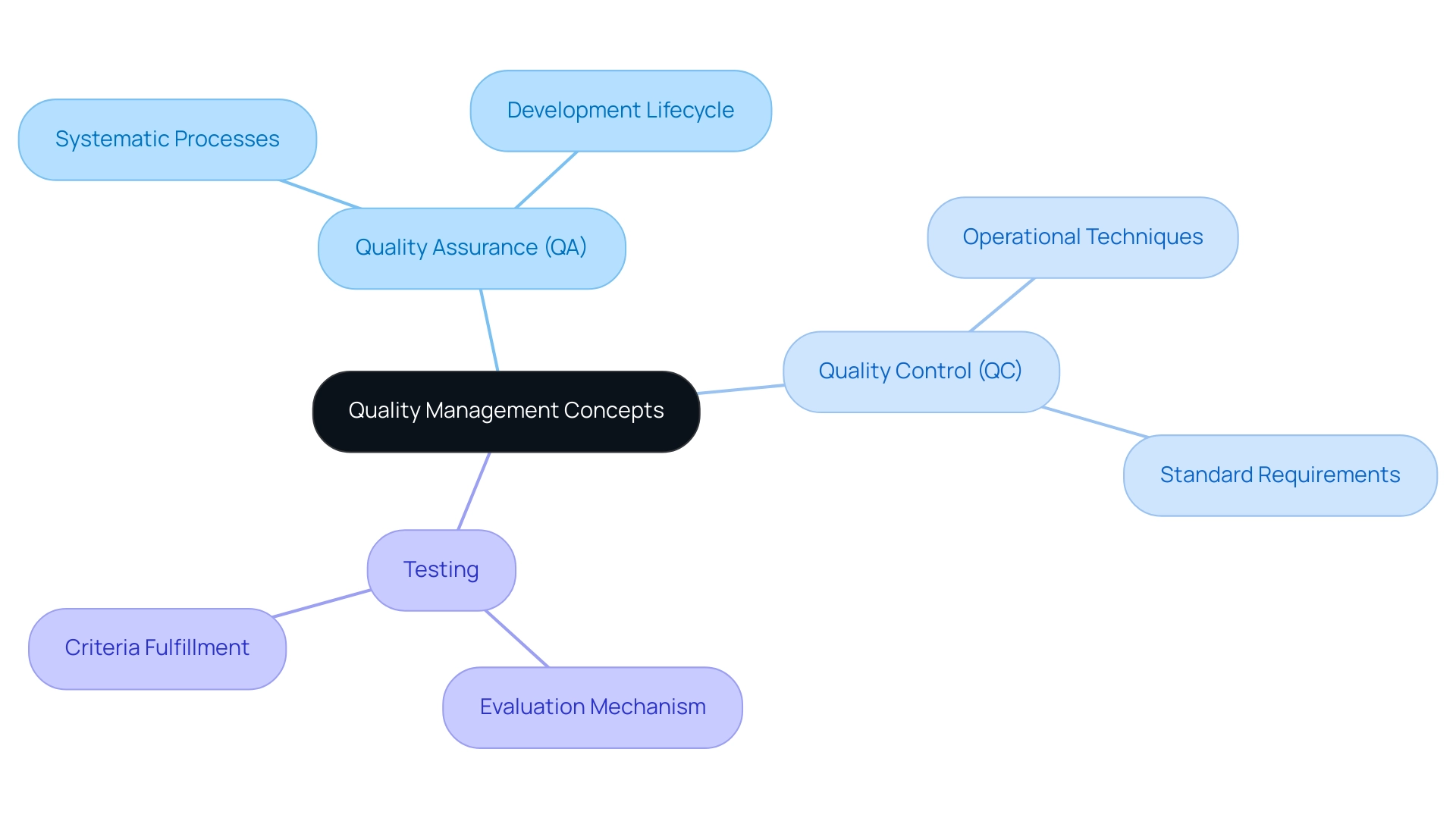
Distinguishing Between Quality Assurance and Quality Control
Quality Assurance (QA) is fundamentally proactive, aimed at preventing defects through thorough planning and systematic activities that incorporate quality into every stage of development. This proactive approach is validated by testimonials from satisfied clients like Ross Graham, who highlights how OpsNinja's thorough inspections, complete with feedback, images, and videos, enabled him to effectively address product issues before shipment. This underscores OpsNinja's pivotal role in preventing manufacturing issues and safeguarding brand reputation through expert inspections.
In contrast, Quality Control (QC) is typically reactive, focused on identifying defects post-production through inspection and testing methods. According to the American Society for Quality (ASQ), "companies that invest in management practices report a 40% reduction in customer complaints," which directly enhances overall customer satisfaction. Understanding this distinction between QA and QC is crucial; it empowers organizations to adopt strategies that not only prevent issues but also foster continuous improvement.
Furthermore, understanding AQL (Acceptable Quality Level) numbers is essential for oversight in supply chain management. These metrics not only assist inspectors in determining how many items to test from a batch but also contribute significantly to improving overall item standards and customer satisfaction. By ensuring that product standards meet specified criteria, AQL numbers help safeguard your brand from negative reviews and poor customer experiences.
The Shiraz Heart Study exemplifies how structured approaches to assurance can yield high-standard data collection, ultimately informing better health outcomes. This study emphasizes the significance of meticulous standards in achieving reliable results, paralleling the proactive strategies businesses should adopt to align with customer needs and expectations. By prioritizing these proactive assurance strategies, organizations can reinforce loyalty and trust, ensuring that customer needs are at the forefront of their goals.
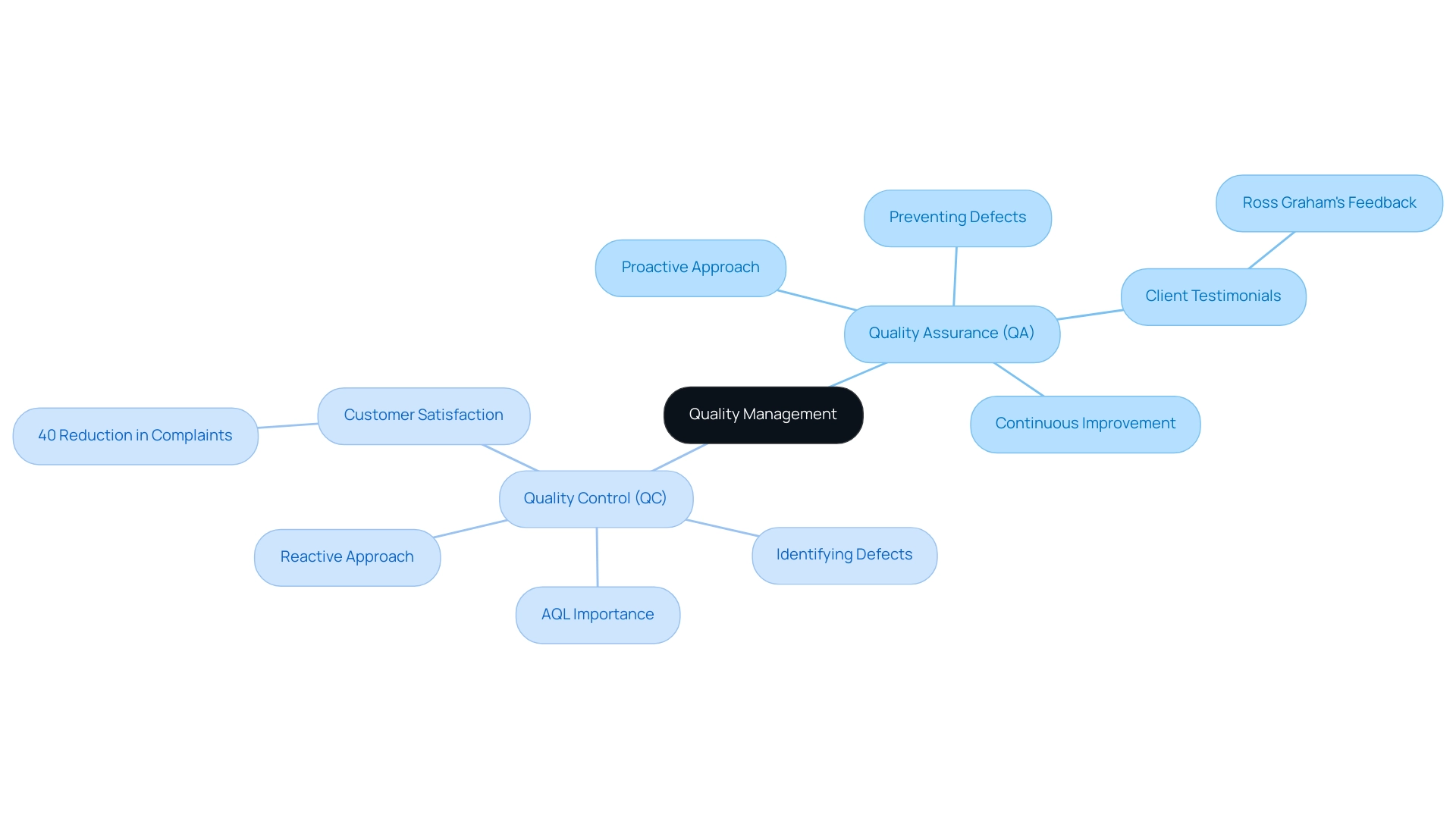
Core Principles of Software Testing
The core principles of software evaluation are essential for establishing effective practices that enhance software quality and reliability, particularly through the use of quality assurance terminology. Key principles include:
-
Early Assessment: Initiating evaluations at the earliest stages of development is crucial for identifying potential issues before they escalate.
Engaging testers early not only leverages their attention to detail but also their extensive interaction with the application, allowing them to pinpoint facets that may otherwise be overlooked. As highlighted by industry experts, including your testers as early as possible in the SDLC process can be beneficial, as they often have the most contact with the application under discussion. -
Defect Clustering: Empirical evidence indicates that a limited number of modules frequently represent the bulk of defects, making it essential to focus evaluation efforts on these high-risk areas to maximize efficiency. The case study titled 'Impact of Software Bugs' illustrates how software bugs can vary in impact, from minor issues to significant failures that can cause system crashes or blackouts. Understanding the nature of these bugs is essential for improving technology reliability.
-
Pesticide Paradox: The effectiveness of evaluations diminishes when the same assessments are repeatedly executed. To combat this, test cases must be regularly reviewed and updated to uncover new defects, ensuring continuous improvement in evaluation methodologies.
-
Testing Shows the Presence of Defects: It is vital to recognize that testing can only demonstrate the existence of defects; it cannot guarantee that the system is devoid of issues.
-
Absence of Errors Fallacy: A product may be free of known defects, yet this does not imply it meets customer expectations or needs. Significantly, merely 4% of dissatisfied clients express their grievances directly to a company regarding a negative experience, emphasizing the necessity of tackling quality concerns. Grasping this nuance is crucial for aligning outcomes with user satisfaction.
These principles establish the foundation for modern application evaluation methods, directing experts toward approaches that incorporate quality assurance terminology to improve defect identification and aid in overall system reliability.
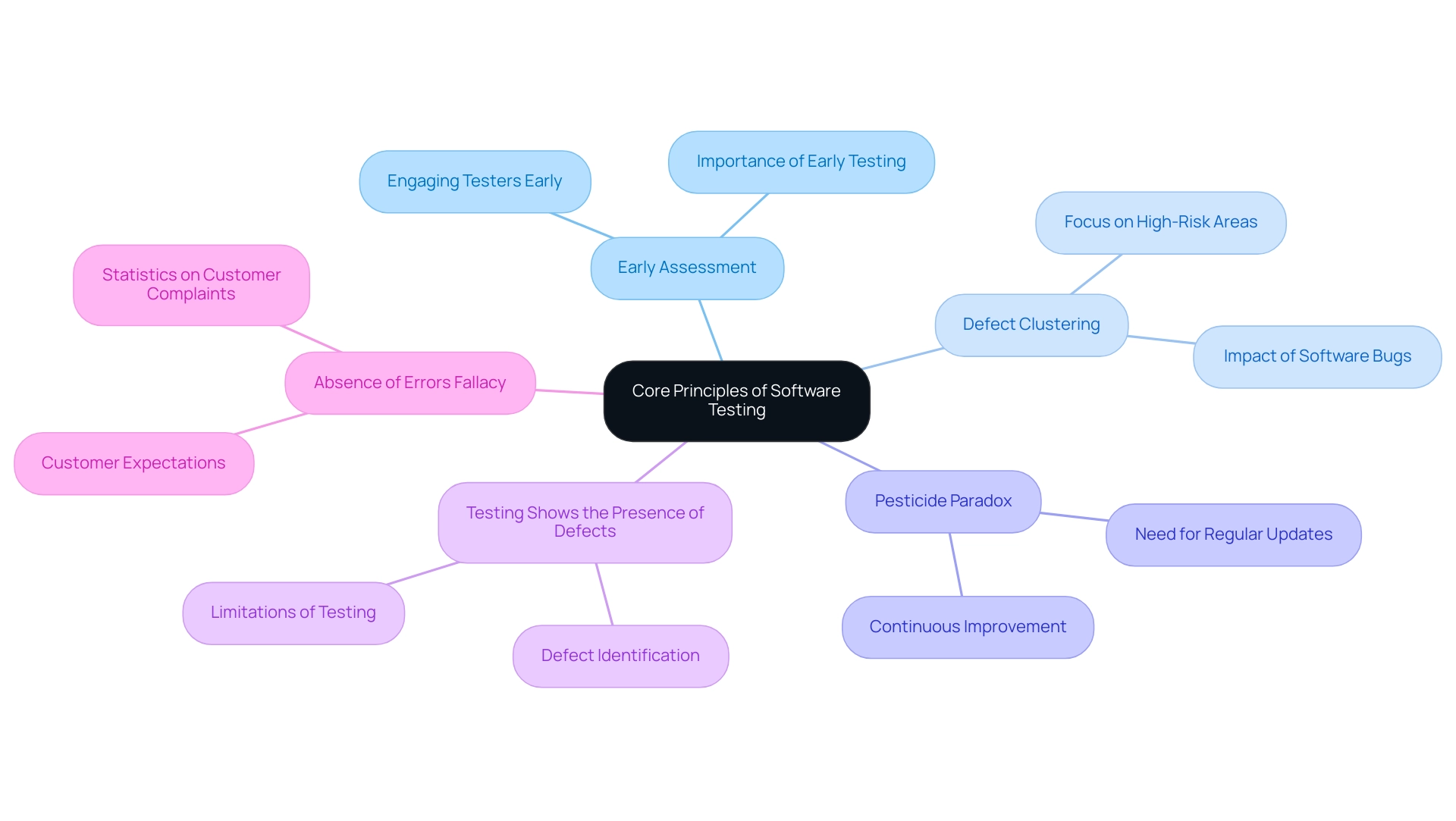
Exploring Different Types of Software Testing
Software evaluation encompasses a range of methodologies, each contributing significantly to the quality assurance terminology in the QA process. The following are key categories of program evaluation:
- Unit Testing: This involves testing individual components or modules in isolation to verify their functionality. It serves as the foundation for developing dependable applications, ensuring that each piece operates as intended.
- Integration Testing: This step assesses how different modules or components interact with each other. By identifying issues that arise when integrating these units, it ensures a seamless workflow across the application.
- System Testing: This comprehensive evaluation assesses the complete and integrated system against defined requirements. It verifies that the system meets all specifications before it is released.
- User Acceptance Testing (UAT): Conducted by end-users, UAT is essential for verifying that the application meets user requirements and is prepared for deployment. Its importance is highlighted by the high success rates linked to effective user acceptance evaluation, which can dramatically influence user satisfaction and success.
- Regression Testing: This type ensures that new changes or enhancements do not adversely affect existing functionalities. It is vital for preserving system integrity over time.
Each of these evaluation types plays an important role in upholding standards and dependability, as defined by quality assurance terminology, before products reach consumers. Notably, 60% of organizations using test automation report significant improvements in application quality, highlighting the effectiveness of these methodologies. Moreover, with fewer than 50% of firms currently employing AI capabilities for assessment automation, there is a significant chance to enhance precision, speed, and cost-efficiency in evaluation strategies.
The worldwide application evaluation market is anticipated to expand to $109.5 billion by 2027, propelled by progress in AI and other developing technologies. This growth highlights the necessity for advanced assessment solutions and methodologies. As Edsger Dijkstra aptly stated,
Evaluation shows the presence, not the absence of bugs
— a reminder that thorough evaluation is vital for delivering high-quality software.
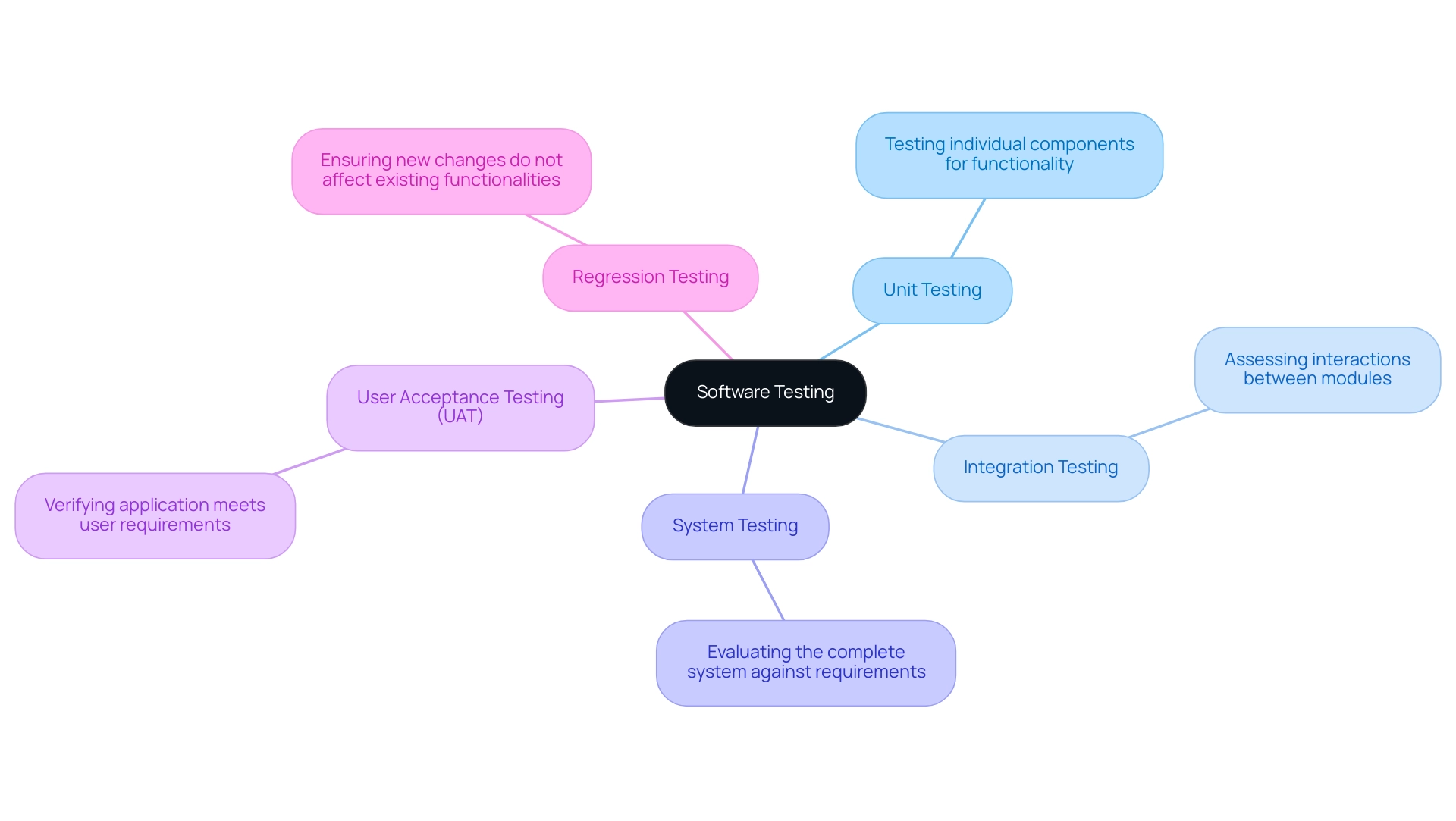
Understanding the Software Testing Life Cycle
The Software Testing Life Cycle (STLC) is a structured framework that consists of several critical phases, which are essential for achieving the goals outlined in quality assurance terminology. These phases include:
- Requirement Analysis: This initial phase involves a thorough understanding of the project requirements to identify what needs to be tested.
- Test Planning: Defining the scope, approach, resources, and schedule for evaluation activities is crucial in this phase, as it sets the groundwork for all subsequent steps. As Hitesh Sharma, a core member of the Sales Department at TatvaSoft, notes, understanding different methodologies of software development is vital for effective test planning.
- Test Case Design: In this phase, detailed test cases are crafted, outlining specific conditions and expected results to ensure comprehensive evaluation coverage.
- Test Environment Setup: Here, the necessary infrastructure is established to enable evaluations, ensuring that the environment accurately reflects the production setting.
- Test Execution: This phase entails executing the tests as per the predefined test cases, collecting data on outcomes for analysis.
- Test Closure: The final phase assesses completion criteria, taking into account factors such as test coverage, standard, cost, time, and alignment with critical business objectives.
The importance of these phases is underscored by the case study titled "Testing in Two Days," where QA expert Amy Reichert discusses strategies to enhance efficiency throughout the STLC stages, particularly under tight timelines. By following the STLC, organizations can implement a structured approach that not only simplifies the evaluation process but also improves the overall standard of releases. Notably, the software development landscape encompasses 559 total categories, highlighting the necessity of a robust STLC to navigate this complexity.
The emphasis on meticulous test planning is particularly important, as it directly impacts the efficiency and effectiveness of the testing process, ensuring that projects meet their quality assurance terminology goals even under tight timelines.
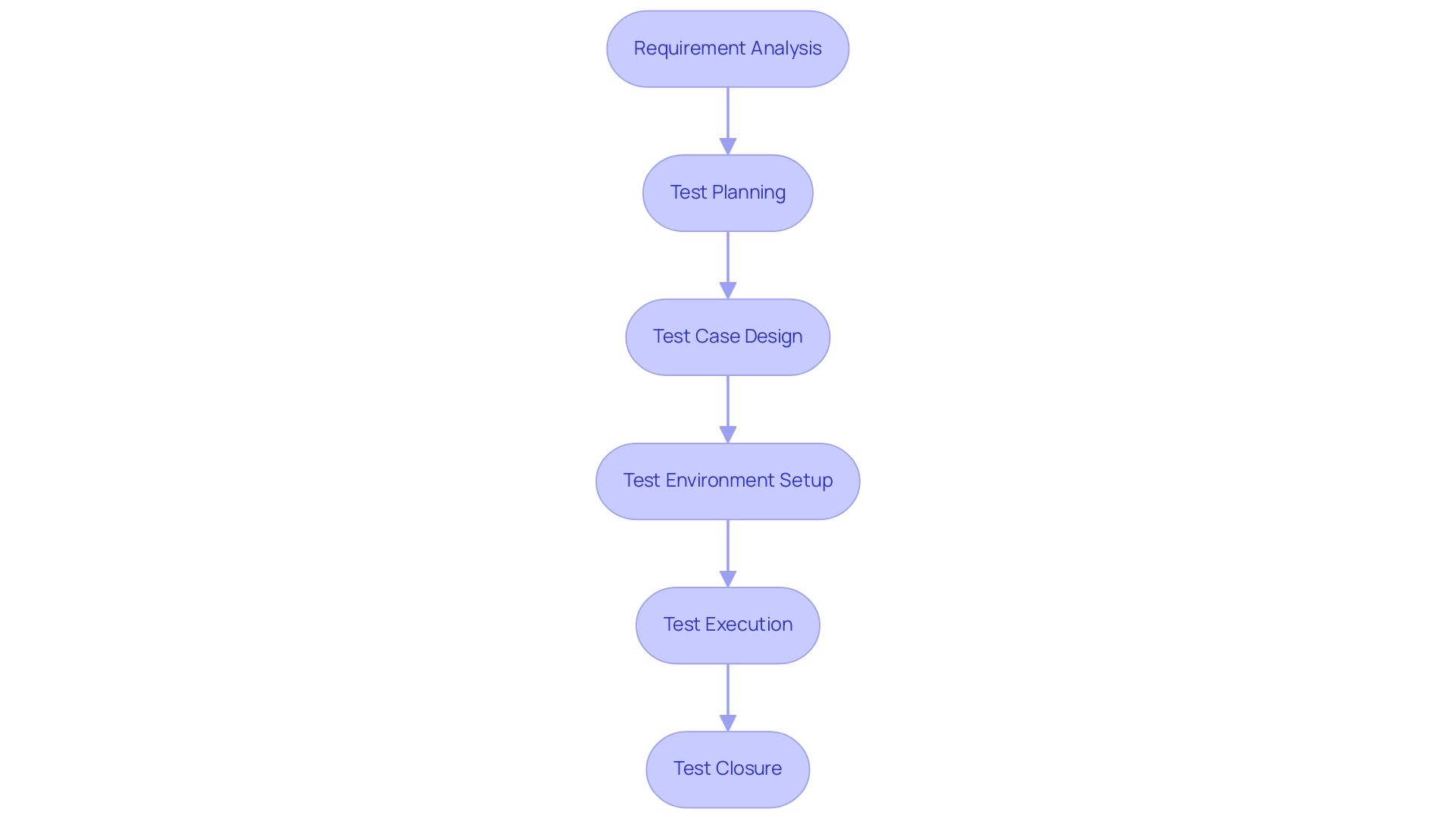
Conclusion
The intricate relationship between Quality Assurance (QA), Quality Control (QC), and software testing is crucial for organizations striving to achieve excellence in their products. By understanding the proactive nature of QA, which focuses on preventing defects through systematic processes, and the reactive approach of QC, aimed at identifying issues post-production, companies can implement effective strategies that enhance overall quality management. Valuable insights from case studies, such as those illustrating OpsNinja's impact on client success, underscore the importance of tailored quality checks and inspections in improving customer satisfaction and brand reputation.
Moreover, the core principles of software testing serve as essential guidelines for maintaining high standards. Emphasizing early testing, defect clustering, and the need for continuous improvement, these principles enable organizations to detect and address issues before they escalate, ensuring that software releases meet user expectations. Different testing methodologies, including:
- Unit testing
- Integration testing
- User acceptance testing
each play a pivotal role in the software development lifecycle, contributing to the overall reliability and quality of the final product.
Finally, adopting a structured Software Testing Life Cycle (STLC) not only streamlines the testing process but also helps organizations navigate the complexities of software development. By meticulously planning and executing each phase of the STLC, businesses can enhance their quality assurance objectives and ensure that their software offerings align with customer needs. As the landscape of software development continues to evolve, prioritizing these quality management strategies will remain vital for organizations aiming to deliver exceptional products and foster lasting customer loyalty.



